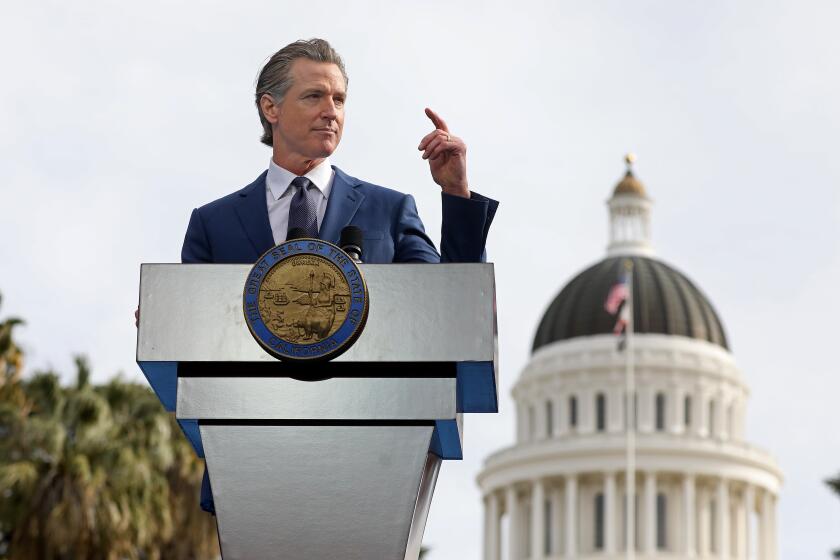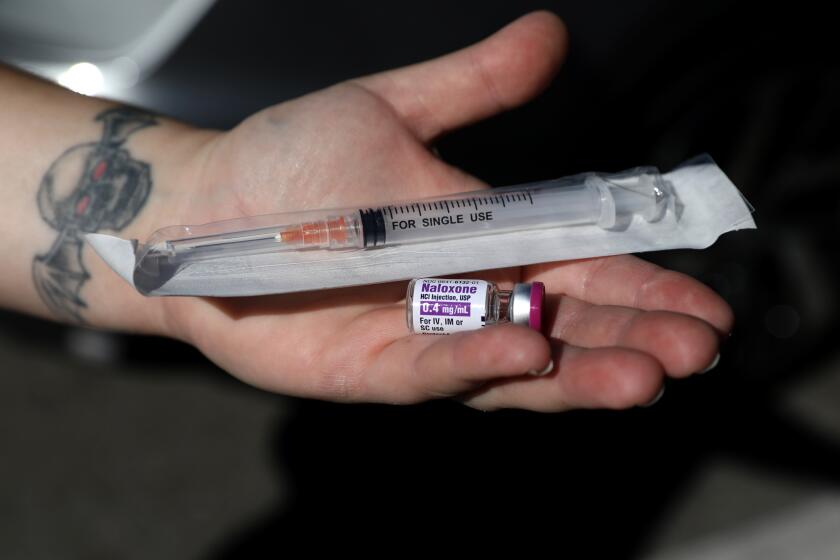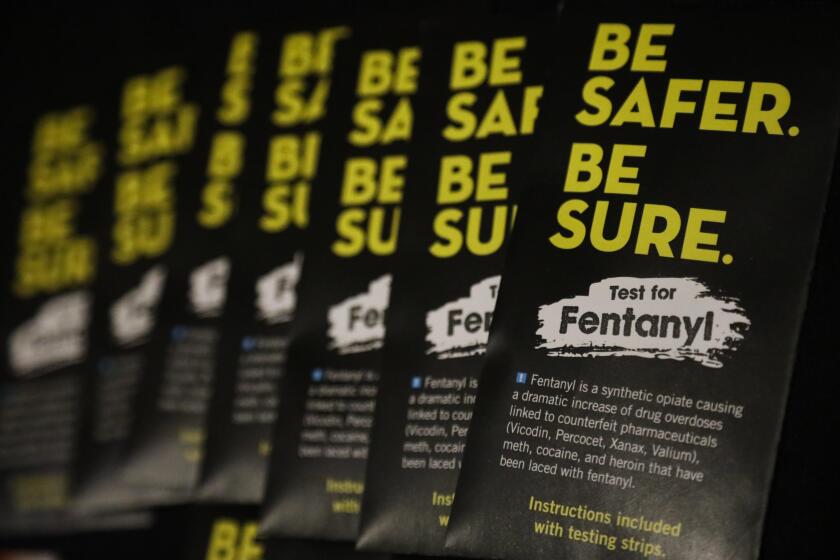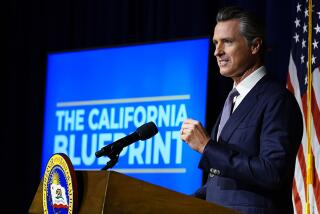Newsom budget includes naloxone for middle and high schools while largely avoiding cuts

- Share via
Gov. Gavin Newsom on Tuesday pledged to provide naloxone — the overdose reversal drug — to every middle and high school, a low-cost but pressing need in a proposed education spending plan that would sustain school budgets but largely end a massive recent expansion of K-12 and college funding.
The overall budget proposal for K-12 school systems was one of general stability in ongoing funds — although local officials are worried about the wind-down of one-time COVID-relief dollars, the effect of inflation and declining revenues from a weakened economy.
The state four-year college systems have concerns of their own, despite a proposed 5% increase in ongoing base funding. Because last year’s budget was boosted by one-time dollars, the cumulative effect would be a net decrease — and colleges also have been hurt by inflation. In addition, the University of California must pay for significant compensation increases for graduate teaching and research assistants — agreed to after a five-week strike.
In an item that caught UCLA faculty off guard, some funding for UCLA would be tied to an apparent effort to open admission access: The university must accept at least a specified minimum of students who transfer from community college. It was unclear why Newsom proposed it and how it was vetted. UCLA has no shortage of community college applicants and meets the state’s directive of enrolling one transfer student per two first-year students. Six of UC’s nine undergraduate campuses participate in the system’s “transfer admissions guarantee” program but UCLA, UC Berkeley and UC San Diego do not.
UC President Michael V. Drake expressed gratitude to Newsom for continuing to honor a previous multiyear funding commitment despite the challenging state revenue picture, saying it would help expand enrollment and hire more faculty.
George Blumenthal, executive director of the Center for Studies in Higher Education at UC Berkeley, also applauded the continuation of funding increases but said they would not help UC fully meet several challenges — including financing new contracts offering significant pay and benefit improvements to four graduate and professional worker unions that launched a massive strike last year.
He also said UC is expected to increase enrollment, but the budget proposal delays funding this year for expansion projects at two of the campuses with room to grow – UC Riverside and UC Merced.
Newsom said he was continuing to prioritize education despite a budget forecast of higher expenditures than revenues. The proposed state budget is $297 billion, with a projected deficit of $22.5 billion. The governor’s spending blueprint will be negotiated in the coming months and Newsom will present a revision in May ahead of lawmakers’ June 15 deadline to approve a state budget.
Gov. Gavin Newsom plans to deal with a projected $22.5-billion state budget deficit by reducing investments in climate change programs.
“Regardless of this modest shortfall, we’ll continue to make unprecedented investments in transforming public education and higher education,” Newsom said Tuesday. “We’re going to continue these commitments. ... We’re not backing off.”
The plan to provide naloxone was one of the most dramatic in the budget, although far from the most expensive — with an estimated cost of $3.5 million, part of $97 million in new spending related to the fentanyl and opioid crisis, a growing concern for parents and school district officials.
“This is a top priority,” Newsom said. “There’s not a parent out there that doesn’t understand the significance of this fentanyl crisis.”
Dr. Mark Ghaly, the state’s health and human services secretary, called the effort “a small but mighty investment.”
Ghaly said there was a supply issue recently due to an explosion of demand for naloxone, but he predicted a quick rollout.
“There’s already a head start on that,” he said. “Many schools, especially over the last three to six months, have been requesting naloxone. ... We’re going to need to sit down, figure out where there are schools that haven’t yet requested and then once the budget, we hope, is approved, move quickly to provide that supply across the state.”
The state and L.A. County have worked hard to make Naloxone more widely available. One of the hurdles, though, has been the price of the inhalable version, Narcan.
There’s bipartisan support in the Legislature for providing naloxone, which can revive an overdose victim if quickly applied — and which is safe and especially easy to use in the nasal spray form. But there had been a question of funding. Under the proposed budget, the funding would come largely from settlements with companies accused of contributing to the nation’s opioid epidemic, Ghaly said.
The responses to the budget in education circles ranged mostly from gratitude to relief that Newsom’s proposals weren’t worse.
“This fiscal bolstering is imperative to help temporarily offset the one-time federal funds that will culminate in the forthcoming years,” the Los Angeles Unified School District said in a statement.
Susan Markarian, president of the California School Boards Assn., praised a long list of ongoing initiatives that were maintained “despite plunging revenues.” All the same, “more action is required to address the staffing shortage and provide pension relief ... at a time when 25 cents of every dollar received by local schools goes toward pension obligations.”
The long-standing pension obligations were a result of past years of poor fund management that Newsom, and his predecessor tried to remedy.
The association also was disappointed that Newsom has called for block grants — which can fund wide-ranging school-district programs — to be cut by $1.2 billion, about a third. That’s about equal to the amount of new money that school systems will receive — and must use for — arts-related programs as a result of voters passing Proposition 28 in November.
Significant investment in early education will continue — including gradually ramping up a new and free but optional school year for all 4-year-olds. There will still be substantial funding for workforce training for early education teachers and programs for 3-year-olds with special individual or family needs.
One new addition is $500 million set aside for schools that serve the neediest populations. A relatively modest addition is $200 per high school senior for “cultural enrichment experiences” such as museum visits, or theatrical performances.
Despite some cuts or funding delays, Newsom and his allies were at pains to point out that funding for education has accelerated rapidly in recent years.
State spending on education “used to be one of the most inequitable and lowest in the country in 2013,” said state Board of Education President Linda Darling-Hammond, a key Newsom advisor. “Now we are well above the national average in a very progressive funding system that pays attention to student needs.”
Community college enrollment is at its lowest level in 30 years as educators scramble to meet the needs of a new generation of students who may be questioning the value of higher education.
Some of the relative explosion in spending was hardwired into state law by voters through a ballot initiative called Proposition 98 — which increases education spending as tax revenues increase. Newsom and the Legislature then decide what to prioritize — and whether dollars will be doled out in ongoing or one-time efforts.
At the community college level, Newsom is sticking with plans to set aside money to stabilize campuses hammered by enrollment that dropped during the pandemic to the lowest levels statewide in 30 years. Community colleges are funded largely based on enrollment, but those rules are suspended through June 30, 2025.
But if colleges can’t show enrollment increases, Newsom said he would consider removing such funds from college districts that are failing to bring in students.
Sbeydeh Viveros-Walton, director of higher education at Public Advocates, a nonprofit law firm and civil rights advocacy group, praised Newsom’s approach.
“The enrollment crisis at the community colleges has been pretty acute,” she said. “And it’s encouraging to see the administration will be monitoring the enrollment and holding colleges accountable.”
Newsom also delayed — by a year — $250 million that is part of $2.2 billion earmarked for affordable housing for college students.
Viveros-Walton said it does not appear the proposal would affect student housing projects that have already been approved for grants.
Fentanyl is often mixed with other drugs (including heroin, methamphetamine and cocaine) to increase potency, but it can be deadly. Test kits can help.
More to Read
Sign up for Essential California
The most important California stories and recommendations in your inbox every morning.
You may occasionally receive promotional content from the Los Angeles Times.

















